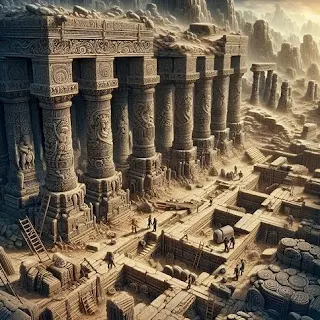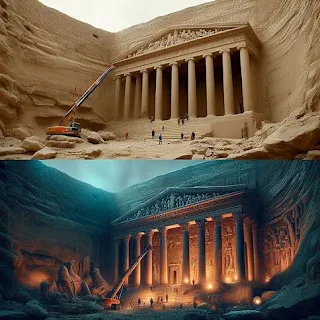A deep dive into the archaeological excavations at the sacred Ram Mandir site in Ayodhya, India, which have uncovered traces of ancient temples and artifacts.
 |
| Archaeological excavation in progress at the Ram Mandir site |
Discovery History: The Archaeological Excavations at Ram Mandir in Ayodhya
Introduction
The Ram Janmabhoomi site in Ayodhya, Uttar Pradesh has been a pivotal center of India's religious and political landscape for decades. Believed by many Hindus to be the birthplace of Lord Ram, the Babri Masjid built there in 1528 CE by Mughal emperor Babur was demolished by Hindu activists in 1992, sparking widespread communal riots across India.
In a landmark judgment in 2019, the Supreme Court of India allowed the construction of a Ram Temple in the disputed area, while ordering that an alternative plot of land be given for a mosque. This cleared the path for archaeological excavations of the 2.77 acres of Ram Janmabhoomi land.
The excavations, which began in early 2020, have already uncovered traces of ancient temples, shrines, and artifacts pointing to human habitation thousands of years ago. As the digging continues, it is exposing buried layers of history and providing priceless insights into Ayodhya's past as a thriving religious site.
 |
| Unearthed pillars/foundations |
Read more about the company who built the ayodhya Ram mandir
Significance of the Excavations
The Archaeological Survey of India (ASI) is carrying out the excavation project with utmost care and rigor. Their findings will shed light on the origins of the sacred site and provide credibility to the beliefs associated with it.
Politically, the excavations represent a new chapter in the Ram Mandir dispute. After decades of communal conflict and legal battles, there is now an opportunity for reconciliation and closure through scientific evidence. Many hope that this will resolve the long-standing religious controversy and usher in peace between India's communities.
 |
| Ayodhya cityscape |
Spiritually, the excavations carry profound meaning for devout Hindus who revere Ayodhya as the birthplace of one of their most beloved deities, Lord Ram. Uncovering material proof of Ram's connection to the land is considered sacred. The findings may reveal details about rituals, ceremonies, and worship practices dating back millennia.
Historically, the project will uncover Ayodhya's ancient past as a center of power, culture, and faith in the heart of India. The buildings, tools, pottery shards and other artifacts can help map the region's inhabitants, rulers, trade routes and more over thousands of years. Piecing together this archaeological record fills critical gaps in our knowledge of Indian civilization.
Read more about ayodhya Ram mandir construction committee
What the Excavations Have Found So Far
In the first round of digging from March-August 2003, the ASI unearthed temple remains, dozens of pillar bases, and ornate brickwork pointing to a monumental structure dating back to the 12th century BCE. Findings also showed human activity at the site as early as the 13th century BCE.
 |
| Temple artifacts found |
Read more about The Ram Mandir in Ayodhya - Tracking the Temple's Construction Timeline
The latest excavations which started in early 2020 have further confirmed a large temple complex existed on the site centuries ago.
Some key discoveries made so far are:
Stone columns and foundations - Temple pillars made of black touchstone, pillars with decorative engravings, pillar bases arranged in orderly rows, and sandstone wall foundations indicating massive structural remains.
Shrines and sanctum - Remains of a small shrine from the 10th century BCE and a sanctum sanctorum have been found. The sanctum's raised circular platform matches Hindu temple design described in ancient texts.
Ornate bricks and flooring - Intricately carved bricks with floral motifs have been unearthed along with flooring made of brick jelly, lime mortar and other materials pointing to a sophisticated temple architecture style.
 |
| Before/after excavation area |
Drainage system - An advanced drainage system including earthen pots, sandstone and terracotta rings has been discovered, indicating sound engineering practices.
Hindu religious symbols- Architectural artifacts like amalaka (stone disks), kapotapali (dove tails) and other symbols associated with Hindu shrines and temples.
Animal figurines - Terracotta figurines of various animals further confirm a Hindu shrine was located at the site.
As the excavations continue to greater depths, archaeologists expect to find relics preserved in the lower levels dating back to temple structures from the 6th-12th centuries CE and even earlier periods.
 |
| Archaeologists examining finds |
Read more about the height of ayodhya Ram mandir
Analyzing the Finds using Technology
Archaeologists are leveraging modern technologies including 3D laser scanning and drone surveys to meticulously document the excavation finds and analyze them:
3D Scanning - Advanced 3D laser scanners digitally map the excavated features in exquisite detail. The 3D scans help recreate and study buried structures digitally. Photogrammetry using drone cameras supplements these scans.
 |
| 3D scanning |
GIS Mapping - The excavated artifacts are carefully logged using GPS markers. The resulting Geographic Information System helps visualize and study spatial patterns.
 |
| GIS Mapping |
Material Analysis - Optical microscopy, spectroscopy, Carbon-14 dating and other material analysis techniques help ascertain the composition and origins of structures and objects found.
Computer Modeling - Powerful software helps create digital 3D models from excavation data to simulate the layouts of demolished structures. This aids visualization.
Digital Preservation - High-resolution imagery and 3D models digitally preserve fragile artifacts and temple remains. Digital reconstruction and VR allows virtual site visits.
 |
| Digital preservation |
These technologies eliminate guesswork and enable data-driven analysis of excavated remains from all angles and at micro-level detail. They maximize the knowledge gained from the excavations.
Impact on Ayodhya’s Socio-Cultural Landscape
As the buzz around the excavations grows, Ayodhya is seeing a resurgence in tourism and pilgrimages. The findings are a highlight for visitors and boost civic pride among locals. Infrastructure projects are rapidly being completed in the city to manage added traffic and activity.
 |
| Archaeological tools |
However, some Muslim petitioners in the temple-mosque dispute have raised objections that the excavations are disturbing graves around the site. There are also concerns that excessive focus on unearthing Hindu structures may sideline Ayodhya's medieval Islamic-era history and impact Muslim residents.
But most observers agree the excavations mark Ayodhya’s reemergence as a major religious destination in India. The evidence of long and continuous worship at the Ram Janmabhoomi site is sure to amplify its sacred symbolism. Politically too, the dig has been positioned as honoring Hindu sentiments while respecting India's Muslim legacy.
The Road Ahead
The ASI has estimated it may take over a year to fully excavate and analyze remains from the massive Ram Janmabhoomi complex. Speculation is already rife about what all will emerge from under the demolished mosque site before the planned Ram Mandir construction begins.
For now, archaeologists and historians eagerly await each progress report on finds. Together the artifacts will help reconstruct Ayodhya's past as a flourishing cosmopolitan center where diverse Indic religions coexisted.
 |
| Old paintings of ayodhya Ram mandir |
The excavations represent the intersection of faith, politics, history and academic inquiry. While their long-term impacts will unfold gradually, they have already set the stage for delivering closure on the Ram Janmabhoomi issue and recasting Ayodhya's significance in the 21st century.
Read more about the current status of ayodhya Ram mandir
Frequently Asked Questions on the Ram Mandir Excavations
Q. When did the archaeological excavations at Ram Mandir begin?
- The latest excavations began in early 2020 after the Supreme Court verdict on the Ayodhya land dispute. They are being carried out by the Archaeological Survey of India (ASI). Prior smaller excavations were done in 2003.
Q. What key discoveries have the excavations made so far?
- The dig has uncovered stone columns, floors, wall foundations, drainage systems, shrines, sanctum sanctorum remains and Hindu architectural symbols confirming a vast temple complex existed at the site in ancient times.
Q. How are archaeologists analyzing and documenting the excavated artifacts?
- Through 3D scanning, GIS mapping, material analysis, computer modeling and digital preservation techniques. This minimizes losses and enables thorough examination.
Q. What time periods are the artifacts found belonging to?
- The unearthed materials broadly point to temple structures and habitation from the 10th century BCE to the 12th century CE, with potential for even older relics in lower levels.
Q. How have the excavations impacted Ayodhya's religious tourism?
- The excavations have sparked great interest among Hindu pilgrims and tourists. Ayodhya is seeing major infrastructure upgrades and expects a traffic surge as the Ram Mandir project progresses.
Q. How long will the complete excavation and analysis take?
- The ASI has estimated over a year may be required for fully excavating and documenting remains across the large Ram Janmabhoomi site before temple construction can begin.
Q. What are the key future milestones for the excavation project?
- Deeper excavation to layers and strata dating back thousands of years - This will provide insights into ancient Ayodhya's origins and early heritage.








0 Comments